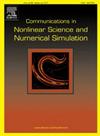Analysis of a new time filter algorithm for the convection problem of superposition of incompressible flow and porous media flow
IF 3.4
2区 数学
Q1 MATHEMATICS, APPLIED
Communications in Nonlinear Science and Numerical Simulation
Pub Date : 2025-02-24
DOI:10.1016/j.cnsns.2025.108684
引用次数: 0
Abstract
In this paper, an efficient numerical algorithm is proposed to solve the convection problem in the superposition of incompressible flow and porous media flow. The displayed numerical method is a first-order -scheme of linear multi-step methods plus time filter algorithm(LMTF), and can effectively increase the convergence order from the first order to the second order with almost no increasing in computation, and easy to implement in program. The stability and error estimation of the decoupled LMTF algorithm are analyzed theoretically. Meanwhile, three numerical experiments are given to illustrate the theoretical results and to show that the second-order convergence, high efficiency and effectiveness of the algorithm. The results demonstrate that the algorithm effectively simulates the geothermal system.
求助全文
约1分钟内获得全文
求助全文
来源期刊

Communications in Nonlinear Science and Numerical Simulation
MATHEMATICS, APPLIED-MATHEMATICS, INTERDISCIPLINARY APPLICATIONS
CiteScore
6.80
自引率
7.70%
发文量
378
审稿时长
78 days
期刊介绍:
The journal publishes original research findings on experimental observation, mathematical modeling, theoretical analysis and numerical simulation, for more accurate description, better prediction or novel application, of nonlinear phenomena in science and engineering. It offers a venue for researchers to make rapid exchange of ideas and techniques in nonlinear science and complexity.
The submission of manuscripts with cross-disciplinary approaches in nonlinear science and complexity is particularly encouraged.
Topics of interest:
Nonlinear differential or delay equations, Lie group analysis and asymptotic methods, Discontinuous systems, Fractals, Fractional calculus and dynamics, Nonlinear effects in quantum mechanics, Nonlinear stochastic processes, Experimental nonlinear science, Time-series and signal analysis, Computational methods and simulations in nonlinear science and engineering, Control of dynamical systems, Synchronization, Lyapunov analysis, High-dimensional chaos and turbulence, Chaos in Hamiltonian systems, Integrable systems and solitons, Collective behavior in many-body systems, Biological physics and networks, Nonlinear mechanical systems, Complex systems and complexity.
No length limitation for contributions is set, but only concisely written manuscripts are published. Brief papers are published on the basis of Rapid Communications. Discussions of previously published papers are welcome.
 求助内容:
求助内容: 应助结果提醒方式:
应助结果提醒方式:


